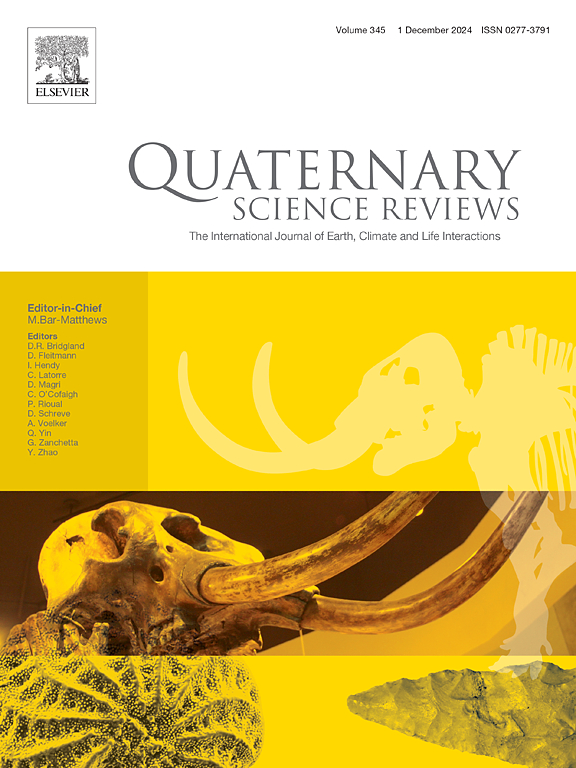山地景观:南高加索、扎格罗斯和阿尔博尔斯的晚更新世动物考古
IF 3.2
1区 地球科学
Q1 GEOGRAPHY, PHYSICAL
引用次数: 0
摘要
只有少数几个例子说明了旧石器时代中期和晚期对中纬度高地的适应。西南亚多山,包括南高加索(包括亚美尼亚高原)和扎格罗斯山脉和阿尔博尔斯山脉,可以说是最丰富的,拥有许多晚更新世(约130 - 12ka)的考古记录。该地区悠久的动物考古研究历史,特别是在过去二十年中收集的数据,现在足以支持对尼安德特人和现代人类生存和活动模式的研究。在本文中,我综合了南高加索地区和扎格罗斯/阿尔博尔兹地区现有的动物考古数据。利用动物群体的丰度指数和地语学变量,我检验了一个零假设,即人类狩猎的可用猎物与景观上的丰富程度成正比。为此,从生物气候变量和非人类产生的更新世动物群中推断出自然丰度基线。与遗址占用强度相关的地理和分类模式与相关的外部参考进行了评估,这些参考是经过充分研究的黎凡特南部动物考古记录,代表了一个更温暖、更适宜居住的地区。零假设只得到部分证实,使猎物选择模式,狩猎专业化和多样化的识别成为可能。虽然承认该地区的考古可变性,但研究表明,南高加索和扎格罗斯/阿尔博尔斯的旧石器时代中期和晚期居住主要是短暂的,证明了遗址居住强度低,即使有,人口增长也很少。似乎居住在该地区的所有群体都有能力实施高度选择性的游戏采购策略,开发广阔的领土,占领许多短期营地,其中一些战略定位是拦截迁移的游戏。旧石器时代中期和晚期的人口都是由小而高流动性的群体组成的,他们零星地居住在崎岖的地形上;他们在恶劣的气候条件下生存,完全不受环境承载力的限制。这种情况有助于将多山的西南亚视为更新世时期的地理死胡同;这表明,无论其生物和文化背景如何,人类群体都根据该地区的自然条件采取了类似的行为。本文章由计算机程序翻译,如有差异,请以英文原文为准。
Thin on the mountainous landscape: The Late Pleistocene zooarchaeology of the southern Caucasus, Zagros, and Alborz
Only a handful of examples speak for Middle and Upper Paleolithic adaptations to mid-latitude highlands. Mountainous southwest Asia, consisting of the southern Caucasus (including the Armenian Plateau) and the Zagros and Alborz ranges, is arguably the richest, featuring numerous Late Pleistocene (ca. 130–12 ka) archaeological records. The region's long zooarchaeological research history and especially the data gathered during the last two decades are now sufficient to support a study of Neanderthal and modern human subsistence and mobility patterns. In this paper, I present a synthesis of the available zooarchaeological data from the southern Caucasus and the Zagros/Alborz. Using abundance indices of animal groups and taphonomic variables, I test the null hypothesis that humans hunted the available game proportionally to its abundance on the landscape. To this end, the natural abundance baselines were extrapolated from bioclimatic variables and nonhuman-generated Pleistocene faunas. Taphonomic and taxonomic patterns that pertain to site-occupation intensity were evaluated against a pertinent external reference, the well-studied zooarchaeological record of the southern Levant, representing a warmer and more habitable region.
The null hypothesis was only partially confirmed, enabling the identification of prey choice patterns, hunting specialization, and diversification. While acknowledging the region's archaeological variability, the study showed that the Middle and Upper Paleolithic habitations in the southern Caucasus and Zagros/Alborz were primarily ephemeral, attesting to low site habitation intensity and little, if any, population growth. It seems that all groups inhabiting the region could afford to practice highly selective game procurement strategies, exploiting vast territories and occupying many short-term camps, some strategically positioned to intercept migrating game. Both Middle and Upper Paleolithic populations consisted of small and highly mobile groups that sporadically inhabited the rugged landscape; they lived under harsh climatic conditions well under the environmental carrying capacity. This scenario contributes to viewing mountainous southwest Asia as a geographic cul-de-sac during the Pleistocene; it demonstrates that regardless of their biological and cultural backgrounds, human groups adopted similar behaviors in accordance with the regions' natural conditions.
求助全文
通过发布文献求助,成功后即可免费获取论文全文。
去求助
来源期刊

Quaternary Science Reviews
地学-地球科学综合
CiteScore
7.50
自引率
15.00%
发文量
388
审稿时长
3 months
期刊介绍:
Quaternary Science Reviews caters for all aspects of Quaternary science, and includes, for example, geology, geomorphology, geography, archaeology, soil science, palaeobotany, palaeontology, palaeoclimatology and the full range of applicable dating methods. The dividing line between what constitutes the review paper and one which contains new original data is not easy to establish, so QSR also publishes papers with new data especially if these perform a review function. All the Quaternary sciences are changing rapidly and subject to re-evaluation as the pace of discovery quickens; thus the diverse but comprehensive role of Quaternary Science Reviews keeps readers abreast of the wider issues relating to new developments in the field.
 求助内容:
求助内容: 应助结果提醒方式:
应助结果提醒方式:


